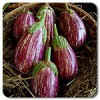 Eggplants are members of the nightshade family Solanaceae. Cultural practices employed in eggplant production are similar to tomatoes and peppers. In south Florida, where winters are mild and freezes are infrequent, eggplants are planted from August to March. This 5-page fact sheet is a guide to eggplant varieties commonly used in Florida. Written by Monica Ozores-Hampton, and published by the UF Department of Horticultural Sciences, October 2014.
Eggplants are members of the nightshade family Solanaceae. Cultural practices employed in eggplant production are similar to tomatoes and peppers. In south Florida, where winters are mild and freezes are infrequent, eggplants are planted from August to March. This 5-page fact sheet is a guide to eggplant varieties commonly used in Florida. Written by Monica Ozores-Hampton, and published by the UF Department of Horticultural Sciences, October 2014.
http://edis.ifas.ufl.edu/hs1243
Tag: Eggplant
Heirloom Eggplant Varieties in Florida
 Eggplant has a colorful heritage. It was first domesticated more than 4,000 years ago. Ancient Chinese crossbred varieties with different shapes and colors. It migrated to Egypt during the 9th to 12th centuries AD, the Moors introduced eggplant to the Spanish, who took the eggplant to South America around 1650, and in 1806, Thomas Jefferson introduced the eggplant to the United States after receiving the fruit from a friend in France. As opposed to the modern-day hybrid cultivars, heirlooms are old cultivars generated by handing down seeds from generation to generation. This 6-page fact sheet is a guide to heirloom eggplant varieties used in Florida. Written by Monica Ozores-Hampton, and published by the UF Department of Horticultural Sciences, November 2014.
Eggplant has a colorful heritage. It was first domesticated more than 4,000 years ago. Ancient Chinese crossbred varieties with different shapes and colors. It migrated to Egypt during the 9th to 12th centuries AD, the Moors introduced eggplant to the Spanish, who took the eggplant to South America around 1650, and in 1806, Thomas Jefferson introduced the eggplant to the United States after receiving the fruit from a friend in France. As opposed to the modern-day hybrid cultivars, heirlooms are old cultivars generated by handing down seeds from generation to generation. This 6-page fact sheet is a guide to heirloom eggplant varieties used in Florida. Written by Monica Ozores-Hampton, and published by the UF Department of Horticultural Sciences, November 2014.
http://edis.ifas.ufl.edu/hs1242
SL330/CV228 A Summary of N, P, and K Research with Eggplant in Florida
Revised! SL330, a 13-page illustrated fact sheet by George Hochmuth and Ed Hanlon, summarizes the historical Florida research literature on nitrogen, phosphorus, and potassium fertilization of eggplant. Includes references. Published by the UF Department of Soil and Water Science, August 2010.
http://edis.ifas.ufl.edu/cv228
CIR1264/PI045 Florida Crop/Pest Management Profile: Eggplant
Revised! Circular 1264, an 11-page fact sheet by Mark A. Mossler and O. Norman Nesheim, profiles eggplant production in Florida, including production facts, regions, practices, worker activities, and pest management. Includes references. Published by the UF Department of Horticultural Sciences, March 2010.
http://edis.ifas.ufl.edu/pi045